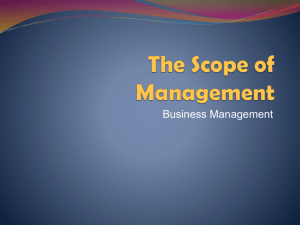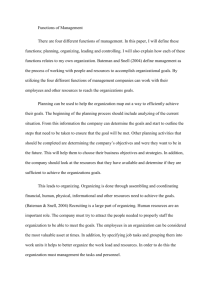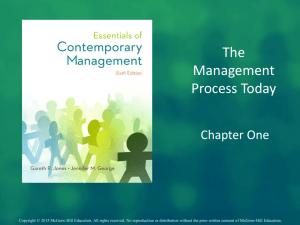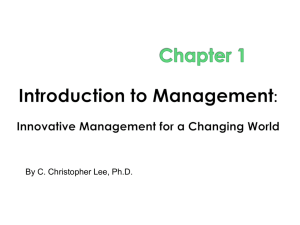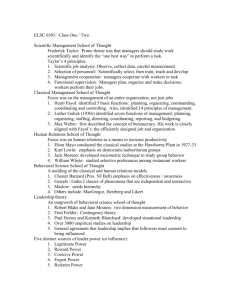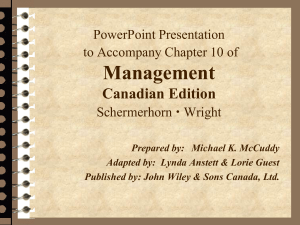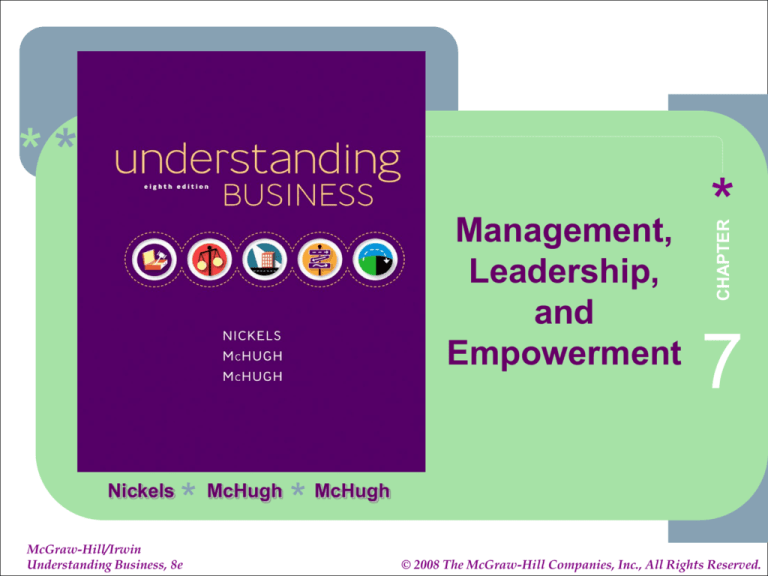
*
*
*
Management,
Leadership,
and
Empowerment
Nickels
*
McGraw-Hill/Irwin
Understanding Business, 8e
McHugh
*
*
CHAPTER
**
7
McHugh
1-1
7-1
© 2008 The McGraw-Hill Companies, Inc., All Rights Reserved.
*
*
*
New Management
Roles
• Skilled communicator
• Team player and a
planner
• Coordinator
• Organizer
• Supervisor
7-2
*
*
*
New Management
I. MANAGERS’ ROLES ARE
EVOLVING.
Learning goal 1
Explain how the changes that are
occurring in the business
environment are affecting the
management function.
7-3
*
*
*
New Management
II.FUNCTIONS OF MANAGEMENT.
Learning goal 2
Describe the four functions of
management.
7-4
*
*
*
III. PLANNING: CREATING A
VISION BASED ON VALUES.
Learning goal 3
Relate the planning process and
decision making to the
accomplishment of company goals.
A. Decision Making:
Finding the Best Alternative.
7-5
*
*
*
New Management
IV. ORGANIZING: CREATING A
UNIFIED SYSTEM.
Learning goal 4
Describe the organizing function of management.
A. Tasks and Skills at Different Levels of
Management.
B. The Stakeholder-Oriented Organization.
C. Staffing: Getting and Keeping the Right
People.
7-6
*
V.
LEADING:
PROVIDING
*
AND VALUES
* CONTINUOUS VISION
.
Learning goal 5
Explain the differences between
leaders and managers, and describe
the various leadership styles.
A. Leadership Styles.
B. Empowering Workers.
C. Managing Knowledge.
7-7
*
*
*
VI. CONTROLLING:
MAKING SURE IT WORKS
.
Learning goal 6
Summarize the five steps of the
control function of management.
A New Criterion for Measurement:
Customer Satisfaction.
7-8
*
*
*
N
Managers get things done by using
organizational resources.
At one time, managers were called BOSSES,
and their job was to tell people what to do.
Today, managers must
GUIDE, TRAIN, SUPPORT, MOTIVATE, and
COACH EMPLOYEES
rather than TELLING them what to do.
7-9
*
*
*
N
7-10
*
*
*
N
7-11
*
*
*
N
7-12
*
*
*
N
7-13
*
*
*
Managing for the Future
1.
2.
3.
4.
5.
6.
7.
8.
Prepare for the unexpected
Faster reaction times
Flatter structure
Build teams
Grow globally
Develop cultural sensitivity
Invest in technology
Develop a family work
atmosphere
9. Create vision
10. Enhance competencies
7-14
*
*
*
Managing
Prepare for the unexpected
7-15
*
*
*
Management Functions
• Planning
• Organizing
• Leading
• Controlling
7-16
*
*
*
PLANNING
PLANNING includes anticipating future
trends and determining the best
strategies and tactics to achieve
organizational goals and objectives.
The trend today is to have PLANNING
TEAMS monitor the environment.
Planning is called the KEY MANAGEMENT
FUNCTION because the other functions
depend on having a good plan Planning
7-17
*
*
*
ORGANIZING
ORGANIZING includes designing the
structure of the organization and creating
conditions and systems in which
everyone and everything work together to
achieve the organization’s goals and
objectives.
Many organizations today are DESIGNED
AROUND THE CUSTOMER.
Organizations must remain flexible and
adaptable to respond to customers’
changing needs.
7-18
*
*
*
Management Functions
• Planning
• Organizing
• Leading
• Controlling
7-19
*
*
*
Management Functions
• Planning
• Organizing
• Leading
• Controlling
7-20
*
*
*
Planning: Create Vision
• Set Vision, Goals,
Objectives
• Vision and Mission –
• Objectives – Specific,
Short-Term
• Continuous Process
(SWOT)
Why Organization
Exists, Purpose of
Organization
• Goals – Broad, LongTerm
7-21
*
*
*
Questions of Planning
1. What is the situation now?
•
Where do we want to go?
2. How can we get there from
here?
•
•
•
•
Strategic Planning
Tactical Planning
Operational Planning
Contingency Planning
7-22
*
*
*
SWOT Analysis
Potential Internal
STRENGTHS
Potential Internal
WEAKNESSES
Potential External
OPPORTUNITIES
Potential External
THREATS
7-23
*
*
*
Planning Functions
7-24
*
*
*
Decision Making: Steps
1. Define
7. Determine
2. Describe
Decision
Making
6. Do
5. Decide
3. Develop
Alternatives
4. Develop
Agreements
7-25
*
*
*
Organizing
• Skills/Tasks
• Stakeholders
• Staffing
7-26
*
*
*
Management Pyramid
President,
Division
Heads, Plant
Mgrs.
Vice Pres.
Top
Management
Middle Management
Employees
Foreman,
Dept Heads
Supervisory (First-Line)
Non-supervisory
7-27
*
*
*
Required Management Skills
• Technical Skills
• Human
Relations Skills
• Conceptual
Skills
7-28
*
*
*
Is It Difficult to be
a Leader Today?
Less Challenging (1%)
Don’t Know (1%)
No Change (9%)
More Challenging
(89%)
Source: USA Today
7-29
*
*
*
Successful Leadership
• Communicate a Vision
• Establish Corporate
Values
• Promote Corporate
Ethics
• Embrace Change
7-30
*
*
*
Leadership Styles
• Autocratic
• Participative
(Democratic)
• Free-rein
7-31
*
*
*
Four Leadership Types
• Rationalists
• Humanists
• Politicists
• Culturists
Source: CIO Nov 2003
7-32
*
*
*
Autocratic Leadership
Making
managerial
decisions without
consulting others
7-33
*
*
*
Participative Leadership
• Democratic
• Managers and
employees
working
together to
make decisions
7-34
*
*
*
Free-rein Leadership
• Managers set
objectives
• Employees are
relatively free to do
whatever it takes to
accomplish those
objectives
7-35
*
*
*
Empowering Employees
• Empowerment: Giving
employees the
authority and
responsibility to make
decisions.
• Enabling: Giving
workers the education
tools needed to make
decisions.
7-36
*
*
*
Manager’s
Empowerment Checklist
• TARGET
• TRUTH
• TOOLS
• TRACKING
• TRAINING
• TOUCH
• TIME
• TRUST
Source: Empowerment Checklist, Cathcart Institute, 2004, www.cathcart.com.
7-37
*
*
*
Knowledge Management
• Do you want to know • What do I still not
more about your
know?
customers?
• What about
competition?
• Whom should I be
asking?
• What information
would make the
company more
effective in the
marketplace?
7-38
*
*
*
Controlling
Feedback
Are standards
realistic?
5. If needed, take
corrective action
4. Communicate
results
1. Establish
clear standards
2. Monitor and record
performance
3. Compare
results against
standards
7-39
*
*
*
Are You a
Micromanager?
• Do you have strategic initiatives that you
have not addressed?
• Do you often check on your employees
for quality control?
• Do you often check on your subordinates
throughout the day?
• Do you seldom take a vacation?
• Is there a lot of turnover?
Did you answer YES to any question?
Source: CFO May 2005
7-40
*
*
*
Most Critical Trends,
Management Concerns
•
•
•
•
•
Globalization
Improving Knowledge Management
Cost and Cycle Time Reduction
Improving Global Supply Chains
Manufacturing at Multiple Locations and
in Many Countries
• Managing More Part-time, Temporary and
Contract Workers
Source: Quality Digest 2004
7-41


